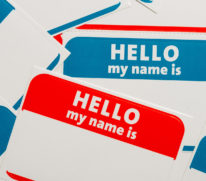by Jo Stubbings, Herald-Sun, 1992
They look innocent enough. They’re small, modest, compact. People will always start smiling when they’re handed around, handshaking, telling stories, doing deals.
Business cards really are the passport to success. But just try translating them. It can be murder.
Like the blurb on a best seller, these neat little tags are built to summarise the vital statistics of their owners. Talk to any self-respecting translation company and they will tell you that the humble business card is the bane of their life.
Translating into Bengali a brochure on intergalactic strathothermic ionisation is infinitely preferable to taking a stab at Brian Bell’s business card in Japanese – even if he is the managing director.
It all boils down to “what’s in a name?” A person’s title, for example, is a particularly hard act to follow.
English titles are wonderfully vague. You can be an analyst, researcher, coordinator, officer, administrator, advisor, supervisor, consultant and all the while sit at the same desk! Does Swedish differentiate between advisor and consultant? Is there a coordinator in Urdu or do they stick to administrators?
And, what about those “mouthful” titles – can Swahili stomach a senior financial analyst – corporate risk manager?
The problems are compounded when translating into the Asian languages. Differences in company structure and hierarchy have a lot to do with this. In Japan, the structure is clear and uncluttered, based on lineal organisation. Everyone knows his position and who is above or below.
This is not necessarily the case in Australia. Ms Jenkins might be regarded as chief executive of Trueblue Tractors Ltd, but then there is the chairman of the board, so he really is the head.
Executive director might be clear to us, but in Japanese it has to be narrowed down to tasks and responsibilities to determine where the person actually fits in.
In Japanese, there are two little characters, depending on context, that can mean a person is company head, executive director, managing director, chairman, chief administrator. And what really curdles your bean curd is that titles for the same position can vary from company to company within Japan.
The trick is to trial your business cards on people in the know before they go to print. But, don’t seek too many advisers or you’ll be reeling at the variety of versions.
Personal names are another thorn in the side. Fraternising with Chinese, Japanese, Korean and Arabic speakers will call for your own name to be translated on the card.
This means the translator must draw on the characters or letters of the relevant language that most closely imitate the sound of the name. This is called transliteration. Plain old John might hand out his card and find himself greeted as Jarn, Joyn, Jeearn or Jan. A slip of the tongue in Arabic and John becomes “a small gulf”. Again, it is important to ascertain the correct pronunciation of the name in its original form.
It is also useful to check on whether the transliteration has a separate meaning in the other language. Sally Smith transformed into Korean might mean “prickly pear with one serve of rice”. If so, the translator will have to slightly distort the pronunciation for the sake of diplomacy.
Names of groups and bodies produce their own share of bother. There are groups, organisations, associations, companies, industries, boards, committees, councils and administrations. Misunderstand the exact composition of a group and you have a major muff masquerading at the top of the card.
The story of the Australian Meat Board has gone down in the translators’ hall of fame.
There were two Serbian versions of this title, which took the honors. One read: “The Australian Board Made Out of Meat” and the other simply said “The Australian Meat Plank”.
Translating business cards into Chinese is a challenge. The first question is where are they going to be used? There are two forms of written Chinese – the simplified and the traditional forms; or short and long forms.
In mainland China and Singapore the simplified form is used, while in Taiwan and Hong Kong it’s the long form. Most Chinese understand the traditional form, but not everyone is up with the short.
Lamenting over the layout of a business card can have you diving in all directions. There are so many ways to go – top to bottom, bottom to top, right to left, left to right, right, left right.
Japanese and Chinese can be set vertically or horizontally with emphasis on order of importance of the information.
The company name usually comes first, followed by John Smith, his title, country, capital city, suburb, street name and street number. In Arabic, you take a shift to the right, but when using numbers for landline and mobile, otherwise it’s back to the old left-right.
Particularly important is pasting the typesetting the right way up. Korean characters might look pretty to the Australian paste-up artist, but they only mean something when they are facing the right direction.
Many translators now choose to leave certain English terms intact. Telephone and email are almost universal and need no translation. In fact, sticking to English is fairly chic – it’s the buzz language.
So, when you next receive a double-banger business card with English on one side and Korean on the other, don’t just whack it into your wallet. Respect it, admire it, hold it up to the light and know that it is the work of a genius.


